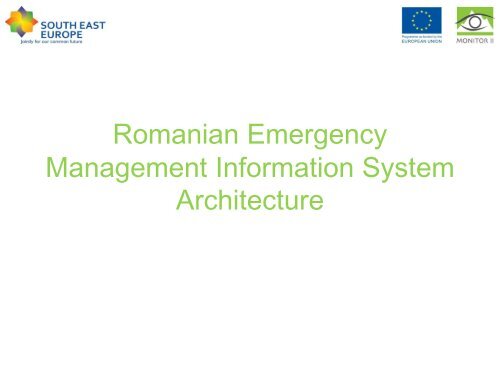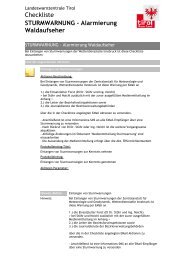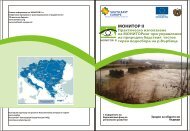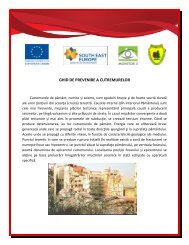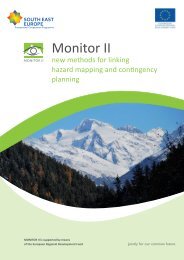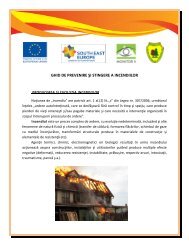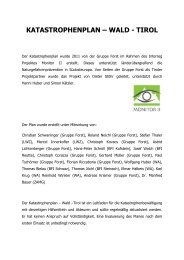Romanian EMIS
Romanian EMIS
Romanian EMIS
Create successful ePaper yourself
Turn your PDF publications into a flip-book with our unique Google optimized e-Paper software.
<strong>Romanian</strong> Emergency<br />
Management Information System<br />
Architecture
Introduction<br />
• <strong>Romanian</strong> <strong>EMIS</strong> is a fully integrated information system connecting all EOCs and<br />
others stakeholders for streamlining information sharing and decision support<br />
for:<br />
o daily routine<br />
o emergency situations<br />
• <strong>Romanian</strong> <strong>EMIS</strong> supports all phases of emergency management : mitigation,<br />
preparedness, response and recovery<br />
• <strong>Romanian</strong> <strong>EMIS</strong> is deployed in EOCs of National Emergency Management System<br />
(NEMS):<br />
o Primary national EOC (NEOC1)<br />
o Secondary EOC (NEOC2)<br />
o Bucharest EOC (BEOC)<br />
o County EOC (CEOC)<br />
o Ministry EOCs (MEOC)
<strong>EMIS</strong> vs<br />
National Emergency Management System<br />
National level<br />
County level<br />
Local level<br />
General Inspectorate for Emergency<br />
Situations (GIES)<br />
NEOC1<br />
NEOC2<br />
County Inspectorate for Emergency<br />
Situations (CIES)<br />
CEOCs<br />
Mobile EOCs<br />
Other Organizations<br />
MEOCs<br />
Regional/County<br />
EOCs of other<br />
Organizations<br />
Local EOCs (Intervention<br />
Subunits, Command<br />
centers, major Economic<br />
Agents EOCs<br />
Extensions
� In <strong>EMIS</strong>, EOCs are acting as<br />
information hubs:<br />
� The information is centralized at:<br />
•County level (CEOC)<br />
•Ministry level (MEOC)<br />
and is replicated at the national level<br />
� These locations are interconnected by<br />
means of a WAN<br />
<strong>EMIS</strong> Conceptual Model<br />
� In case of major emergencies, the CEOC is staffed with<br />
emergency management and experts belonging to various<br />
other independent organizations<br />
� NEOC1 plays a high-level coordinator role during emergency situations NEOC2 is activated in case of nation-wide<br />
emergency situations<br />
� <strong>EMIS</strong> architectural model maps exactly on the current <strong>Romanian</strong> organization model of emergency management<br />
4
<strong>EMIS</strong><br />
Operational Processes<br />
<strong>EMIS</strong> Initialization with<br />
data needed for System<br />
Startup<br />
(performed once, in order<br />
to make the system<br />
operational<br />
Planning Response Recovery<br />
Decision Support<br />
Response & Recovery<br />
Activities Analysis<br />
Support for Planning and<br />
Response Improvement<br />
Data Updates<br />
(Live database- updates<br />
must be performed<br />
permanently)<br />
Decision Support<br />
Reports and<br />
Statistical Analysis<br />
Data Focus<br />
Operational<br />
Focus<br />
Decision<br />
Focus
• Planning:<br />
Business Processes vs<br />
Major Functionalities (1)<br />
o Planning Module with support from the others modules<br />
o WebGIS Module (Planning Mode)<br />
o Task Force Creation Module<br />
o Finance and Budgeting Module<br />
• Response and Recovery:<br />
o Emergency Situation Management Module with support from the others modules<br />
o WebGIS Module (Emergency Situations Management module)<br />
o Task Force Creation<br />
o Evacuation Module<br />
o Casualties, Damages and Material Loses Module<br />
• Alerting and Notification:<br />
o Notification Module alone or integrated in Emergency Situation Management
Business Processes vs<br />
Major Functionalities (2)<br />
• Reporting:<br />
o Situations and Reporting Module<br />
o Intervention Reporting Module<br />
o Budgeting and Financing Module<br />
• Creating, Management and maintaining <strong>EMIS</strong><br />
database (must be a live database):<br />
o Organization Management Module<br />
o Human Resource Management Module<br />
o Logistics, Material Resources and Supply Chain Module<br />
o Risk Management Module<br />
o Hazardous Materials Management Module<br />
o Evacuation Module (Hosting Spaces)<br />
o WebGIS Module (Reference Components Management Mode)<br />
o External Interfaces Module<br />
o Media and Communication Experts<br />
o Administration Module, Nomenclatures Administration Module
112<br />
County Level Operational Proceses<br />
Intervention<br />
Subunit<br />
Operational<br />
Reports,<br />
Requests<br />
County EOC<br />
<strong>EMIS</strong><br />
Decision,<br />
Information<br />
Other<br />
sources<br />
Private and<br />
Volunteer<br />
Intervention<br />
Services, Other<br />
Institutions
NEOC2<br />
<strong>EMIS</strong><br />
International<br />
Structures<br />
(NATO, UE)<br />
<strong>EMIS</strong> Information Workflows<br />
“In Mirror”<br />
CEOC 1<br />
<strong>EMIS</strong><br />
Replication<br />
NEOC1<br />
<strong>EMIS</strong><br />
CEOC 2<br />
<strong>EMIS</strong><br />
Dissemination<br />
Replication<br />
Dissemination<br />
CEOCn<br />
<strong>EMIS</strong><br />
Decentralized structures, hazard economic agents, local commitees for<br />
emergency situations<br />
MEOC 1<br />
<strong>EMIS</strong><br />
MEOC m<br />
<strong>EMIS</strong><br />
NEOC1<br />
Primary National EOC<br />
NEOC2<br />
Secondary National EOC<br />
MEOC<br />
Ministerial EOC<br />
CEOC<br />
County EOC
<strong>EMIS</strong> Application<br />
<strong>EMIS</strong> Application Modular Structure<br />
Administration<br />
Nomenclatures<br />
Administration<br />
Finance &<br />
Budgeting<br />
Intervention<br />
Reports<br />
Public Information Dissemination<br />
WebGIS<br />
Risk<br />
Management<br />
Planning<br />
Emergency Situations<br />
Management<br />
Casualties<br />
Damages and<br />
Material Loses<br />
Situations &<br />
Reporting<br />
Plans<br />
Hazardous Material<br />
Management<br />
Human Resources<br />
Management<br />
Logistics, Material<br />
Resources & Supply<br />
Chain<br />
Task Force Creation<br />
Evacuation<br />
Reports<br />
112<br />
External Interfaces<br />
Organization<br />
Management<br />
Notification<br />
Media &<br />
Communication<br />
Experts<br />
COMMUNICATIONS PLATFORM
<strong>EMIS</strong><br />
Application Physical Architecture
<strong>EMIS</strong><br />
Architecture Conceptual levels<br />
<strong>EMIS</strong> Application<br />
System Software<br />
Infrastructure<br />
Communication and Hardware Infrastructure
Conclusions (1)<br />
• Covers all phases of emergency management: preparation, mitigation, response, recovery<br />
• Covers routine situations / major emergencies situation<br />
• Allows management and coordination of response to emergencies situations<br />
• Allows sharing of information among participating actors to solve an emergency situation<br />
• Ensure traceability of emergency management<br />
• Supports the achievement of high efficiency and performance indicators for emergency situation<br />
interventions<br />
• Provides two working modes – real and simulation. The latter can be used for training activities. Data<br />
separation between the two modes is complete.<br />
• Manages activities related to evacuation operations<br />
• Keep track of victims and material damages<br />
• Keeps track of plans and procedures<br />
• Allows planning activities related to intervention
Conclusions (2)<br />
• Provides structured and tiered notification for various target groups: operational<br />
centers and professional intervention structures staff, emergency committee<br />
members<br />
• Allows recording of information in the national catalog of risks<br />
• Provides management of organizations and individuals, human and material<br />
resources management, management of hazardous substances<br />
• Consolidation of national emergency-related information<br />
• It allows real-time synthetic NEOC information on active emergency situations<br />
• It provides a nationally consistent approach to emergency management<br />
• Provides interface between the component institutions of the National Emergency<br />
Management Situations<br />
• Provides various statistical and consolidated reports, both at county and national<br />
level


